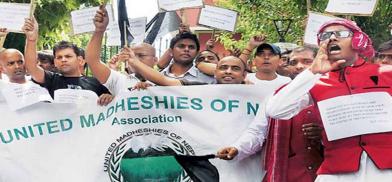Instability in Nepal fuelling Terai autonomy movement
The Terai autonomy movement has been going on since 2007 and has recently gained traction with the armed outfit renewing its political vows at a time when Nepal is facing a host of internal issues, writes Shushant VC for South Asia Monitor

Eight persons have been injured in a bombing carried out in the Siraha district, south-eastern Nepal on March 14. The bomb blast was carried out in the Land Revenue Office, a government office, by using a pressure cooker and has further increased chaos in the society. The Janatantrik Terai Mukti Morcha (Revolutionary - JTMM) claimed responsibility for the blast and has stated it was carried out to highlight corruption in government.
The armed outfit is led by Jaya Krishna Goit. The point that needs to be noted here is that the main motive of the party is not to weed out corruption from the government but to make the Terai region an autonomous region. Goit formed the armed outfit in 2004 after breaking away from the Communist Party of Nepal (Maoist) (CPN-M) due to the inability of the political party to grant autonomous status to the Terai region of Nepal. In Nepal, this political outfit is also known as the Terai People's Liberation Front. With this bomb blast, the Terai independence movement of Nepal or the Madhesi movement has once again come to the forefront.
After a peace agreement was signed in 2006 that put an end to the 10-year civil war between the government of Nepal and the Communist Party of Nepal Maoists, people saw a new fight erupt in southern Nepal, within its Terai region. The violence was initiated by the groups fighting on behalf of those who profess a Madhesi ethnicity. Madhesi people or people of Indian ancestry are those who are residing in the Terai of Nepal and comprising of various cultural groups, including Hindus, Marwaris, Muslims, and indigenous people of the region.
Terai region and its importance
Nepal can be divided into three geographical parts: at the very top is the Himalayan region, where the famous mountains are; in the middle, is the hilly region wherein all the major cities are; and lastly is the Terai region which is used mostly for agricultural purposes.
In short, the Terai region lies in northern India and southern Nepal and the lifestyle of the region resembles that of the Indian states of Uttar Pradesh and Bihar to a large extent. The Terai has 20 of Nepal’s 75 districts and includes close to half the population of Nepal’s 26 million citizens. It also houses over half of Nepal’s agriculture and industry sector outputs.
The JTMM want an autonomous Terai region or a separate state of Madhes for those living in Terai as they feel that the people living in the rest of the country have a different attitude towards the people residing in the Terai region. The party was formed as it felt that the people residing in the region have not been given proper constitutional rights, or economic and political power and they accused the government of the underrepresentation of Madhesis in foreign services, civil service, police, and even the army. They also alleged that even international aid was not being used for the development of the region.
In a 2015 article in The Hindu, the then deputy prime minister explicitly stated that the government has plans to integrate the Terai region into the Nepalese territory and that Nepal will lose its sovereignty if the Terai region gains autonomy and later on independence from the Nepalese state.
Many times, the Nepalese government has stated that the Indian government is involved in supporting the Terai freedom movements, which New Delhi has denied time and again.
Terai people's rights
The main motive behind the bomb blast is for the people of the Terai region to gain access to more political and economic rights. The entire movement is aimed at the restoration of the rights of the people in the Terai region.
The Terai autonomy movement has been going on since 2007 and has recently gained traction with the armed outfit renewing its political vows at a time when Nepal is facing a host of internal issues. Problems such as the split in the Communist Party of Nepal, dissolution of Nepalese Parliament, Chinese interference in Nepalese politics, and sections of the people calling for a return of the monarchy has only provided impetus to the movement.
The only way forward is to conduct elections to set up a stable government in Nepal which should try to look for a solution that benefits the people of the Terai region.
A stable government also means that the Chinese will be unable to interfere in the internal politics of Nepal and will also improve relations between India and Nepal.
(The writer is a Ph.D. in political science from Amity University, India. The views are personal. He can be contacted at simmaksushant@gmail.com)










Post a Comment